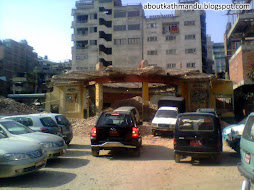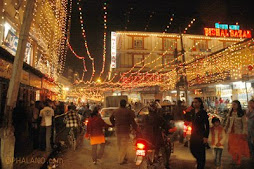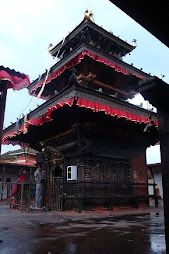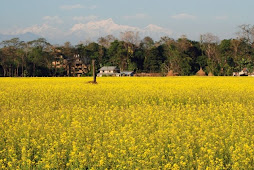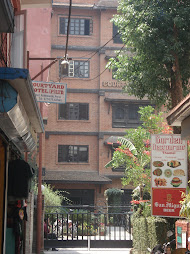Ok, now that Dashain is over, it’s time to talk about another biggest festival of the year – Tihar. While Dashain is considered as the festival when we eat lots and lots of meat, Tihar is when we eat lots and lots of sweets, all home made. Tihar, or its more formal name Deepawali, is a festival of lights. For three days, the city of Kathmandu turns into city of lights. Every doors and windows are lined with flickering candles and/or oil lamps. Set against the soft darkness of the Fall season, the whole city comes to life as if gods have descended upon it to rejoice and celebrate with the mortal beings. Tihar is very different from Dashain in that it does not involved ritual killings that I described in my previous post. Celebrated for five days, Tihar begins with celebrating the life of a crow – the crow, or Kag in Nepali – according to the Hindu mythology, the cawing of a crow symbolizes sadness or grief, so on the day of Kag Tihar people in Kathmandu try to attract the crow to their balcony or the roof by placing offerings of food. Interestingly, the Nepalese also believe that the cawing of a crow on your rooftop means a guest is likely to pay a visit to your house – there is no shortage of guests at your home during Tihar. Kag Tihar is followed by Kukur (dog) Tihar – the dog is considered a messenger of the god of death Yamaraj. According to the Hindu mythology, the dog escorts you to Yamraj’s gate and tries to guide and protect you from the perils of the journey that takes you to the Yamaraj. On this day, you will see dogs (even stray ones) pampered with sweets, and frolicking in the neighborhood wearing marigold garlands around their necks and red tika on their foreheads. Even the nasty dogs are shown a level of affection not usually common among most Kathmanduities when it comes to stray dogs. To everyone’s surprise the dogs do not engage in street brawls on that day, as if they are also in the mood to rejoice, celebrate and at peace with each other acknowledging the right to co-exist. The atmosphere on the streets of Kathmandu seems serene, harmonious and joyful.
The third day of Tihar is Gai (cow) Puja or Laxmi Puja. The mother cow is the holiest of all animals in Hindu mythology, the giver of precious milk to nourish our bodies, the manure to fertilize the earth, and in rural households to purify homes and courtyards with its manure. The cow symbolizes the spirit of kindness, and of motherly love. The cow is worshipped (tika on her forehead, marigold garland around her neck) and offered fruits and homemade sweets. The cow is also a manifestation of the goddess of wealth (Laxmi). In rural Nepal the number of milk giving cows in your livestock shed is often the barometer of your prosperity in the village. As most travelers to Nepal know, the cow is a mighty force even on the most congested streets of Kathmandu where she roams free, unobstructed, and with little care for the imminent dangers from cars, motorbikes, rickshaws and people. Anytime I am on the streets of Kathmandu, for example, on the highly congested section between Indrachowk and Kamalachhi, the sight of a cow and her carefree spirit instills in me a true sense of freedom, a realization that is most unrealizable, imagination that is anything but impossible. So we celebrate Gai Tihar with unflinching spirit and with a care that attains its highest level on that day. We watch her move around the neighborhood with grace, kindness, humility and pure freedom. Families engage in elaborate decorations of their entrances with small prints of Laxmi’s feet, hoping that she visits the house softly at night and brings prosperity to the families. On the fourth day, we celebrate Gobardhan Puja, or Goru (ox) puja. This is the day when farmers worship the mighty Goru, the one that ploughs the earth with its sheer strength and determination. Farmers have special affinity with the Goru, not only it is Lord Pashupati’s carrier, it is also the principal source of labor without which many farmers in the Nepalese hills and terai cannot till their lands.
On the fifth and the final day of Tihar, Bhai Tika is celebrated. Brothers and sisters throughout Nepal reunite and put tika on each other, sisters pray for their brothers’ safety, brothers promise to protect their sisters. Those without a brother or a sister visit the temple in Rani Pokhari, which is opened for public visit only on that day during the whole year. In my family the ritual of Bhaitika takes more than two or three hours. You see, I have four sisters, the tika ceremony is very elaborate, completed in stages starting with putting oil on my head the night before and culminating with the exchange of fruits and sweets the next day. The family ritual on the day of Bhaitika involves the sisters circumnavigating the brother (seated on the ground, legs crossed) and drawing a line of oil and water brushed by fresh dubo (a small clump of fresh grass neatly tied toether) around him, demarcating a boundary which no forces of evil can penetrate. Thereafter, they take turns in putting the multicolored tika on the forehead, the tika is put in a vertical row of red, blue, purple, yellow, green, and black colors. They put garlands of dubo, purple colored makhamali (Globe amaranth / Gomphrena globosa) and marigold flowers around the brother’s neck, give him fruits, homemade sweets (sel, anarsa, khajuri) and masala (dry spices - a mix of almonds, coconut, plum, cashew, etc). In return, the brother puts tika in similar fashion on the foreheads of his sister, starting from the eldest and to the youngest, gives them fruits, sweets and money. The ceremony ends with a family feast.
On the third and the fourth day, the night comes alive. This is the day when children and adults alike band together to form singing groups and visit different homes to sing Deusi (third day) and Bhailo (fourth day) in return for money and/or other offerings. The night is brightly lit with candles and oil lamps, there is music in the air, fireworks sparkle the night sky with radiant colors, children come out on the streets beautifully dressed, and peace and harmony litter the streets of Kathmandu. I participated in these events with almost a missionary zeal. We would plan singing days in advance, preparing a list of homes to visit, and in some cases sending them an advance notice that we would be coming to sing at their house. We would plan our lineup of songs (Deusi or Bhailo were the main songs, but we would also sing other popular Nepali folk and Bollywood songs), instruments to be played and determine who would be playing what. For Bollywood songs, I would be one of the lead vocalists. We would start visiting homes at seven in the evening or as soon as it is dark, working through our neighborhood and then moving on further. Depending on the size of the group (sometimes it would be around 6-7, but mostly it was more than 10 in the group), we would collect various amounts of money during the two nights. Often, we sang and played until mid-night. The money would be spent on some group activities, for example, a picnic at the outskirts of Kathmandu, planned in the days to come. One year, we had more than 20 in the group so we had to rent a minivan to go around, for example, we sang at the western entrance (Keshar Mahal) of the Royal Palace (we had to send a notice several days in advance) and at the Prime Ministers’ official residence in Baluwatar. The beauty of the Deusi song was that as long as you followed its rhythm you could sing almost about anything you wanted, which usually meant singing in praise of the family you were visiting, but also singing about the difficulty faced along our way to the house, our impatience with the time it has taken for the family to give their donations, etc. which were smartly built into our tunes. Our Deusi song went something like this:
Heh…jhilimili jhilla, deusi re!…(glitter galore, deusi re!)
Heh…tato roti milla, deusi re!…(hot bread (we shall receive) deusi re!)
Heh…rato mato, deusi re!…(red mud, deusi re!..)
Heh…chiplo bato, deusi re!…(slippery path, deusi re!…)
Heh…aayon hami, deusi re!… (we came, deusi re!..)
Heh…deusi gauna, deusi re!… (to sing deusi, deusi re!..)
Heh…yo ghar ko rani, deusi re!…(this home’s queen, deusi re!..)
Heh…Kasto ramro bani, deusi re!…(how nice is she, deusi re!..)
And the songs/tunes were played over and over until a family member emerged at the door with donations.
The Bhailo rhythms were different. It started with:
”..bhailini aaye angana, (the choir has come to your courtyard)
..guniyo cholo magan (to ask for a dress; guniyo=skirt, cholo=blouse)
..heh aunsi bara, (this day of the New Moon)
..gai ko tihar bhailo!...” (this cow tihar, bhailo!)
And the beat continued...
Sunday, October 4, 2009
Subscribe to:
Comments (Atom)
